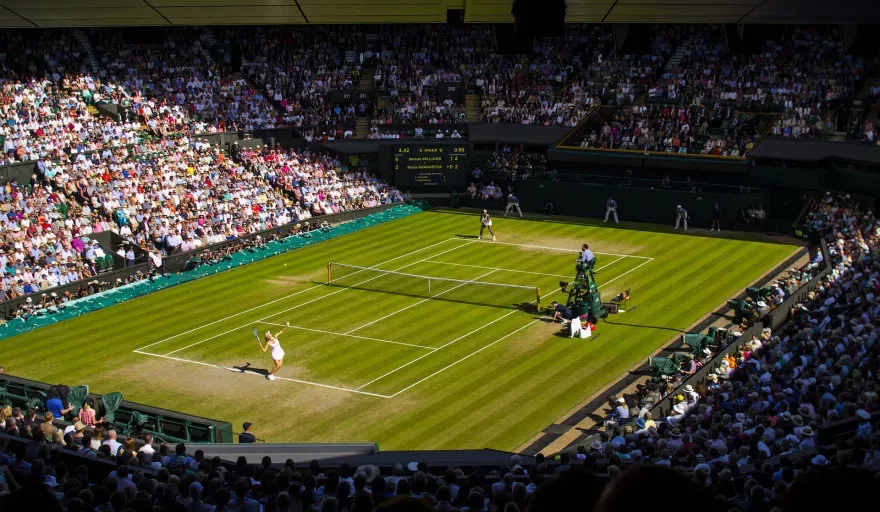When this summer’s Wimbledon was cancelled, IBM and the AELTC rallied to create The Greatest Championships: a unique, immersive tennis experience centred around remastered content.
THE GREATEST CHAMPIONSHIPS
On March 23rd, the UK’s Prime Minister announced lockdown measures for an initial period of three weeks.
Across the country people had to adjust to the ‘new normal’ – home-schooling their children and working remotely – while hoping that the lockdown would soon be lifted.
It came as a huge blow for sports lovers when the All England Lawn Tennis Club (AELTC) announced its decision to cancel the Wimbledon championships on April 1st – unfortunately, it was no April fool.
“With the likelihood that the Government’s measures will continue for many months, it is our view that we must act responsibly to protect the large numbers of people required to prepare The Championships from being at risk,” its official statement read.
For many people, the cancellation of The Championships and other sporting events bought home the enormity of the pandemic. But for AELTC, it was important that tennis lovers were still able to get their fix.
“We wanted to say thank you to our fans by providing some semblance of Wimbledon, and of normality,” explains Alexandra Willis, Head of Communications, Content & Digital. “And we wanted to encourage them to engage with us rather than just be passive consumers of content.”
PLANNING AHEAD BY LOOKING BACK
There were eight weeks between the cancellation statement and the planned date of The Championships. With no live matches scheduled, how was AELTC and its partner IBM going to provide an engaging Wimbledon experience for viewers?
For Willis, the announcement didn’t come as of much as a surprise as it did to the viewing public. One of AELTC’s partners was based in China, and working with them in lockdown from January onwards sparked discussions about what would happen if the virus spread. This led to scenario planning about how the tournament might be affected, and how Wimbledon could be celebrated regardless.
“On the second of April we were already putting together the framework for what that would look like, how we could engage the BBC, how we could engage all of our partners, including IBM, and come together to do something one off but very special,” Willis explains.
AELTC started off with lots of ideas. Ultimately, however, it realised that what it was looking for was a common narrative that everyone could get behind, including broadcasters and the media.
Then came the idea of The Greatest Championships – replaying some of the greatest matches across the event’s history over the original two-week schedule.
“We wanted it to be more than random old matches,” Willis adds. “We wanted to recreate that feeling of anticipation and not knowing quite what’s going to come the next day. That included scheduling early round matches, not just the finals and semi-finals, all the while showcasing a breadth of history.”
The idea was to recreate the experience of watching The Championships as closely as possible, by showing matches in line with rounds as they would ordinarily have progressed. An element of surprise would be preserved by releasing the match schedule at 11am each day, with a choice of different iconic matches to watch.
To implement and enhance its vision, AELTC enlisted the help of its partner IBM. The computing organisation quickly put together a 10-strong team of digital and technical specialists. Central to IBM’s offering this year was the necessity to digitally remaster the video footage of yesteryear. But the first step was to select the matches, a task that IBM and AELTC undertook jointly.
“We selected matches that date as far back as 1977 (the Virginia Wade vs Chris Evert and Bjorn Borg vs Vitas Gerulaitis semi-finals) based on a combination of factors: what was available in the archive; the quality of source content and the quality of the tennis stories both on the court and off,” explains Sam Seddon, IBM Wimbledon Client Executive.
The footage, he continues, was widely divergent in quality. To appeal to modern audience, it had to be remastered. It was also necessary to apply modern statistics to the match and embed them in the video. Break points, aces and more were added as filters into the video replay system.
Each video needed to be enhanced frame by frame – considering each match was several hours long, equating to more than three terabytes of total video data, a lot of computing power was needed. An AI solution running on the IBM cloud (Watson) was used.
As well as being completely remastered, many of the matches were lacking in both graphics and stats. AELTC’s data collection had to re-stat all of the matches so each had a complete dataset. This meant that viewers were able to search through to the most exciting points of the match, rather than always watching them in their entirety.
ENGAGED AND ENERGISED
The social media campaign for marketing The Greatest Championships was simple but hugely effective. Participants were invited to use the deliberately open-ended hashtag #Wimbledonrecreated to share their individual, socially distanced Wimbledon celebrations.
“Sometimes we’re tempted to overcomplicate things but joining in the spirit of Wimbledon was such a simple message, and tapped into the breadth of the fanbase,” Willis comments.
Despite the lack of real-time matches, viewers rallied for the occasion and entered into the spirit of things.
“Everyone was so creative,” Willis continues. “We had people dressed up as umpires at the breakfast table, marking out the court with loo roll and fantastic culinary recreations. I saw one video of people hitting a ball over Highland cows on a Scottish moor.
“It was really heart-warming, the kind of thing advertisers dream of because it’s very true and very human.”
The Head of Communications admits to being surprised at the extent of the appetite for tennis-related content. She was also surprised by the matches that proved to be most popular, in particular 1993’s Andre Agassi vs. Pete Sampras match – although Agassi might be out of the public eye, the two players’ rivalry is legendary.
Ultimately, Willis now aims to expand the interactive offering that AELTC provides.
“The way that we put The Greatest Championships together as an enriched video experience is a really great lesson for us in expanding our video content on Wimbledon.com, and thinking about a direct consumer offering,” she explains.
LESSONS FOR THE FUTURE
Seddon also learned a lot from the eight weeks that his team at IBM spent creating The Greatest Championships.
“Personally, I’m pleased with the speed, agility and ‘one team’ collaboration we demonstrated to get things done,” he says.
“We had just two months to conceive, design and execute a solution for a global audience and that has been well received in the absence of any balls being struck or points won by real-life tennis players on the circuit.”
The ‘one team’ that the IBM Wimbledon Client Executive refers to is comprised of experts from across AELTC and IBM, who can work together year-round on producing a constant stream of innovations. The innovation team works closely with the core delivery team to ensure these products slot seamlessly into pre-existing offerings and channels – and that’s what happened with The Greatest Championships.
Following on from this year’s success, Seddon is already planning for 2021, and has some exciting new innovations in the pipeline.
“We can’t reveal now what they are but there will be a focus on how to use IBM Watson and Cloud solutions to provide unique insights into the players and the sport of tennis, and how to deliver via experiences that can be tailored to each fan’s interests,” he explains.
But of course, neither Seddon nor Willis are able to predict what 2021 will bring. According to Willis, the team needs to be prepared for multiple scenarios.
“Plan for the worst but hope for the best,” she says philosophically. “Flexibility is really important. Making sure we’re aligned with changes in advice and sport in general will be critical.”
For Seddon, the pandemic has bought home the important role technology has to play in sporting events.
“Those sports organisations that were well advanced in their adoption of digital technologies were the ones able to react quickest and deliver the most meaningful experiences to fans during lockdown. We also believe they will be the ones best positioned to develop new opportunities as sport returns,” he explains.
This is because stadiums and other sporting venues will be heavily reliant on technology to reopen, including temperature checks and organising safe distancing through redistributing ticketing.
Undeniably, the pandemic has disrupted people’s lives, at least for the near future. But Seddon believes that despite the unprecedented tragedy, there is a positive from a technology perspective: that this ‘new normal’ was a period when the digital transformation of business and society suddenly accelerated. This is a trend that he hopes will continue.
“What we have now is an opportunity to develop new solutions, new ways of working and new partnerships that will benefit companies and their customers, not just today, but for years to come,” he says.
It is certainly true that IBM’s partnership with AELTC has led to new and unexpected ways of engaging with Wimbledon, even without live matches. We, for one, are looking forward to seeing what they will think up next.































